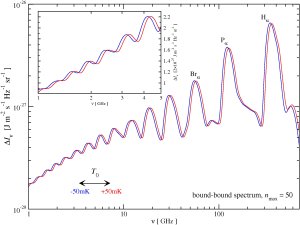|
|  |
Roughly 260,000 years after the Big Bang the initially fully-ionized plasma
became sufficiently cold to allow the existence of neutral hydrogen atoms.
By that time the temperature of the nearly isotropic CMB blackbody radiation,
which is filling the expanding Universe, had dropped to about 3800 K.
The process of recombination is associated with the emission of several photons
by electrons cascading from upper levels of the hydrogen atom to its ground state.
For 40 years the kinetics of cosmological recombination is known to be extremely unusual:
due to the very small expansion rate of the Universe the escape of photons from
the Lyman-α resonance was extremely inefficient.
This strongly enhanced the role of the very improbable two-photon decay
of the metastable 2s level to the 1s state. About 57% of all electrons in
recombined hydrogen atoms reached the ground state via the 2s-1s two-photon transition.
As a result, the kinetics of recombination cannot be described by the formulae
for Saha-equilibrium in cooling plasmas, and recombination was strongly delayed.
In addition, because of the extremely high entropy of the Universe
(with about 2x109 photons per baryon), the primordial plasma
is dominated by photons. Therefore collisions of atoms with electrons and
ions played a negligible role, and the populations of highly excited levels
were completely defined by radiative rates, including stimulated recombination
and induced emission.
Detailed computations have allowed us to calculate the spectrum of the
recombinational radiation arising from all possible atomic transitions
of hydrogen among levels with principal quantum numbers up to 100 (see Fig. 1).
Due to the expansion of the Universe this signal is redshifted more than 1000 times,
so that ultraviolet photons reach the observer in the sub-mm band today.
Transitions among highly excited levels lead to photons that nowadays should
appear at radio frequencies, where experimental techniques developed for the
extremely successful investigations of CMB angular fluctuations
( lambda.gsfc.nasa.gov 2001)
have achieved unprecedented sensitivity. lambda.gsfc.nasa.gov 2001)
have achieved unprecedented sensitivity.
For experimentalists the ratio of the computed signal relative
to the intensity of the CMB blackbody radiation is more representative
(see Fig. 2). Most likely it will be easiest to search for
the distortions under discussion in the low frequency domain, just above 1.4 GHz.
This is because there the contributions from the lines of distant galaxies,
especially due to the 21 cm line of neutral hydrogen, is minimal.
The insert of Figure 2 illustrates the detailed frequency dependence of the
features produced during cosmological recombination. These have a unique "pattern"
which has nothing in common with other widely discussed and well-known foregrounds.
Using the computed "template" observers may have a chance to separate the recombinational
signal from possible sources of noise.
MPA scientists are proposing a new type of CMB experiment:
instead of scanning the sky at given frequency and searching
for tiny angular fluctuations of the CMB temperature,
one should observe a large area of the sky, scanning its
radiation over frequency, and looking for the predicted characteristic
spectral variability. Experiments under construction in the USA to observe
the CMB angular fluctuations will have sensitivities on the level of 10 nK.
The spectral features under discussion have amplitudes between 50 and 100 nK.
It is very important to mention that the recombinational signal should be the
same in any direction on the sky.
The position of the spectral features on the frequency axis strongly
depends on the exact value of the CMB temperature (see Fig. 3 for illustration).
The best and only existing precise measurement of this value, as performed by the COBE
spacecraft, was awarded the Nobel Prize in Physics, 2006. It is very important to have
new independent methods to determine the CMB monopole, and the computations carried
out at MPA might offer such an opportunity. Furthermore, the intensity of the features
depends on the total amount of hydrogen nuclei in our Universe, and is practically
independent of the values of the other key cosmological parameters. If the CMB
monopole temperature is, an observation of these spectral distortions will provide an
additional way to measure the entropy of the Universe. In principle it should
also be possible to determine the abundance ratio between helium and hydrogen,
and to reconstruct the detailed ionization history.
It is worth mentioning that the photons forming these small CMB
spectral distortions were emitted mainly between redshifts z~1300 and 1400,
i.e. before recombination made the Universe transparent,
defining the last scattering surface around z~1100,
at which the observed CMB angular fluctuations were formed.
Therefore, a detection of the recombinational lines in the CMB spectrum
will yield the final proof that recombination has occurred as we think it has.
R.A. Sunyaev and J. Chluba
Publications
Jens Chluba, Rashid Sunyaev
"Free-bound emission from cosmological hydrogen recombination"
A&A, 458, L29 (2006)
Jose Alberto Rubiño-Martín, Jens Chluba and Rashid Sunyaev
"Lines in the cosmic microwave background spectrum from the epoch of
cosmological hydrogen recombination"
Mon. Not. R. Astron. Soc., 371, 1939 (2006)
|


